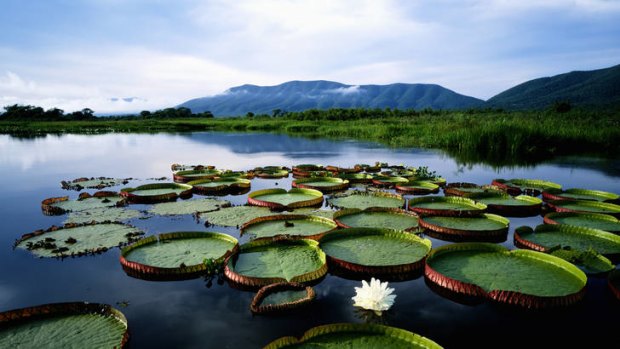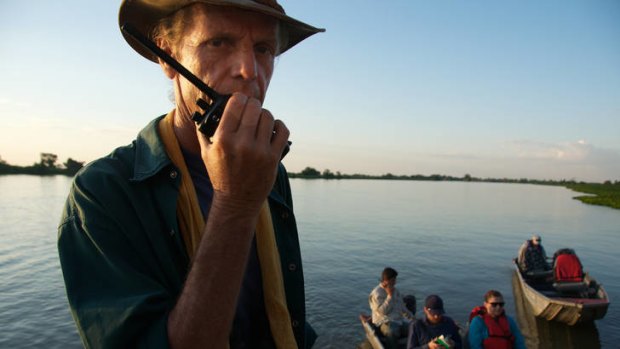
Pantanal boasts the largest contiguous wetlands on the planet.Credit: Alamy
A colourful cast of wildlife characters creates a dawn chorus as Lance Richardson joins the hunt for the Pantanal's coolest cat.
The rooster has nothing on the chaco chachalaca. It sounds like a kookaburra laughing into an oscillating fan, the call starting before dawn and continuing long after everyone has pulled themselves out of bed to contemplate a breakfast of hunted bird. It's part of a veritable orchestra, with cicadas rounding out the percussion section and howler monkeys contributing their best imitations of a category-5 cyclone.
My own feet provide a minor beat as I stumble outside to an elevated boardwalk. It's barely 5am and the guide is fast, flashing a torch around. But there are several good reasons to keep up when you can barely see a thing in the Pantanal: tarantulas, caimans, snakes and bats. All were seen within a 50-metre radius of my room last night. Plus one albino cockroach.

Panatal conservationist Andre Von Thuronyi on the Paraguary River.Credit: Lance Richardson
The Pantanal is in Mato Grosso, western Brazil. Take out a world map and put your finger on the centre of South America: there it is, a sprawling basin biosphere covering about 200,000 square kilometres.
When the Andes rose millions of years ago, the Pantanal sank; every wet season, almost all its surface area slips under water. Fish are pushed in by the rivers; birds invariably follow. Nearly 700 species of bird - swallows and hawks, yellow-billed cardinals, a blue heron from Patagonia - will gorge as the fish become trapped. They move like gusts of confetti, fluttering over dun-coloured foliage between termite mounds and bloated caimans. The symbol of the Pantanal is the jabiru stork, one of the largest birds in the Americas. I have never seen so many birds in my life. But what I've come looking for is something even more remarkable.
The boardwalk thins and dips, tracing a circuitous path through the forest. Then my guide gestures towards the top of a 25-metre tower. The moment we start to climb the staircase, a family of monkeys leap into a neighbouring cambara tree, their anger bellowed through its yellow flowers. They moved in when the tower was finished and they don't take kindly to visitors
co-opting their view. One look will tell you why: from the top the sky is blue and orange, a slow boil above a breathtaking plain of grass and water lilies. Trees grow in isolated groves. On the far horizon is a smudge of light - Cuiaba, home to 800,000 people.
Somewhere out there is the jaguar.
"I don't use music in my car or watch TV," Andre von Thuronyi tells me later. "You just enjoy it." As the owner of the tower and Araras Eco Lodge, inside the Pantanal, von Thuronyi knows the place so well I will spend several days floating down a river in a tinny with him, searching for big cats. He often wears a tilly hat, his shoulder-length grey hair and a gold loop in his left ear creating the appearance of a slightly manic explorer. Like a character imagined by Edgar Rice Burroughs, he has the aura of somebody who has spent a lot of time in wild places.
Von Thuronyi is descended from Hungarian aristocracy, his family having emigrated to Brazil in 1948. Soft-spoken and intuitive, he found his wife in an Indian ashram - and a moral calling after killing a deer with a bow and arrow. The bow and arrow, he says, was meant to even the odds between hunter and prey. It was part of an evolving attitude towards nature. When the deer died, that evolution took a giant leap forward: von Thuronyi looked into its eyes and discovered he was a fierce conservationist. Then he moved to the Pantanal.
His first project focused on birds. Blue macaws were once abundant in Brazil. With the destruction of their primary food source, the acuri palm, populations were decimated (they were also hunted for feathers for Carnival in Rio de Janeiro, and for exotic pets). Araras Eco Lodge was founded to help restore habitat in the Pantanal and raise awareness of their plight. Modest but comfortable, the lodge uses green technology and produces much of its own food - honey, buffalo, lamb. During the dry season, a caiman sometimes sneaks into the swimming pool. Visitors can ride horses and visit the bird-rehabilitation program, where a pair of blue macaws make for happy hosts when I stop by. Araras Eco Lodge works with Bichos Mata, a non-profit agency that rescues illegally trafficked birds and reintroduces them to the wild.
For most people, this would be achievement enough, but von Thuronyi is just getting started.
Another early start, this time in a car: we drive three hours to the Paraguay River, the only drainpipe to the Atlantic Ocean for the Pantanal wetland. A giant houseboat is moored when we arrive, with a spacious living room and nine private cabins named after types of fish. I stay in "Pacu", a relative of the piranha. The captain is named Kurtz. A picture of a jaguar is stuck to his fridge.
Jaguars are a powerful symbol in Brazil. El tigre, the top predator, appears in Amazonian shamanism; chiefs once wore jaguar skin to indicate their status in the tribe. But an ongoing battle with landowners protecting cattle in the Pantanal has reduced population numbers. Like the blue macaw before it, von Thuronyi's new operation is motivated by a goal of preservation.
The houseboat casts off down the river and we pass villages with people clutching umbrellas against the sun. Trees along the banks are strangled by vines as fixed as worry lines. The water is wide and murky brown. Eventually, we reach the outskirts of Taiama, an ecological reserve where fishing is not allowed and jaguars are known to swim.
The next morning we rise early to break away in smaller boats, fanning out to scour the banks with binoculars. Again and again we will do this for several days: von Thuronyi searching for jaguars, poised at the front of the boat or leaning over the side; me staring at strange trees stained an unearthly silver by cormorant guano, or giant spiked lily pads, or logs that could be anacondas if you squint. Mosquitoes come and go. The sun comes and goes. There is a night expedition in which stars and fireflies blend and reflect off the river, creating a sense of dizzying infinitude. Cascadura fish burp bubbles that break the surface while more birds than you can imagine float over wild cotton and sandbox trees with exploding fruit. Sometimes it feels like sailing into a snowstorm.
Jaguars may be the impetus for this voyage, but they're far from the only attraction. At a certain point I have a strange epiphany. Von Thuronyi is standing at the front of the tinny while I hunch on the floor, dangling my hand in the river. "You remind me of Percy Fawcett," I tell him, referring to the British explorer whose obsessive expeditions made him famous until he disappeared in the Amazon jungle.
"Percy Fawcett?" von Thuronyi says, turning suddenly. "I played Percy Fawcett in a movie, Lost in the Amazon. Playing Percy was like exorcising a personality I have. After that, I changed my way of dressing. I had got rid of him. Gone!"
With that, he turns back to the jaguar hunt.
Any visit to the Pantanal is as much about von Thuronyi's vision as it is about the landscape. "When I first arrived in the Pantanal in 1976, I camped for three years. There was nothing. Now, along the road, there are 16 lodges. I've helped farmers open lodges for visitors." Partly, this is an act of cultural protection: locals earn money from tourism, allowing them to continue to raise horse breeds such as the hardy pantaneiro, adapted to the wetlands. But it's also a response to the furious modernisation of Brazil.
In von Thuronyi's view, urbanisation comes with an increasing disregard for nature. "Kids in cities live in shopping malls," he says. "As older people like me die out, there's nobody doing conservation. It's my mission to bring Brazilians closer." He will do this through a sleight of hand. If international visitors show interest in the Pantanal - if they're willing to spend money to come here, supporting jobs in the process - then maybe Brazilians will re-evaluate their attitudes and start preserving the natural bounty of their country. At present, only 3 per cent of the Pantanal is protected. It is the largest contiguous wetland on the planet.
For all our efforts and hours spent drifting on the Paraguay, we don't see any jaguars. Back on the houseboat, a shaky video shows what visitors see if they're lucky. The world's largest rodent, a capybara, stands frozen on the bank. It knows something is wrong, though it can't see what we can see: a jaguar, on its haunches, waiting for the moment to strike. The capybara begins to turn. It looks like a giant wombat. There's a sudden streak of colour, a splash, the two animals disappearing into the river. When the jaguar surfaces, it has the rodent in its jaws. Then it's gone, vanishing into the high grass.
FAST FACTS
Getting there LAN Airlines has a fare from Sydney via Auckland to Santiago, Chile (14hr 35min), with connections to Sao Paulo, Brazil (4hr) from about $1545 low-season return, including taxes. See lan.com. TAM Airlines flies from Sao Paulo to Cuiaba from about $235 low-season return, including taxes.
Staying there Natural Focus Safaris has six-day packages to the Pantanal, including two nights at Araras Lodge and three nights on the Jaguar Houseboat, departing every Monday from Cuiaba. It costs $3729 a person, twin share, including full board and activities. Phone 1300 363 302; see naturalfocussafaris.com.au.
Lance Richardson travelled courtesy of LAN Airlines and Natural Focus Safaris.
Sign up for the Traveller Deals newsletter
Get exclusive travel deals delivered straight to your inbox. Sign up now.